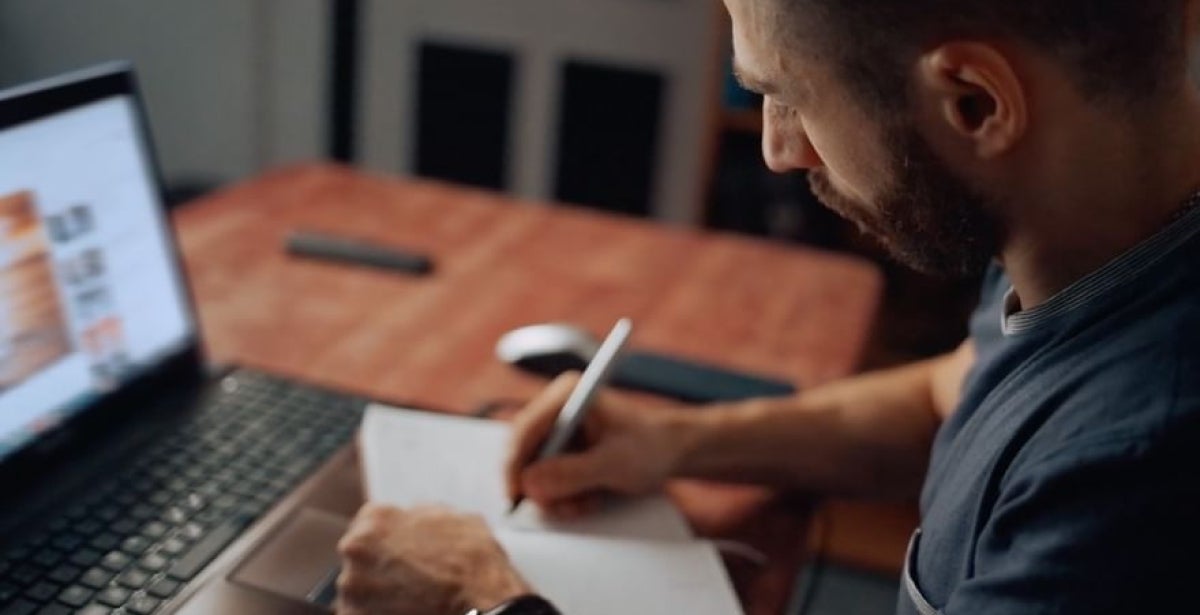
5 Ways To Manage Your Screen Time While Studying Online
What does screen time have in common with chocolate and coffee? Depending on which report you read, they’re either good for you… or bad for you.
One thing we can agree on is that our digital devices enable us to do amazing things. After all, with our phones alone we can manage our busy lives, see our family and friends around the world, and study anywhere at any time.
In fact, supercharging your career through online study that fits in with your existing work and life commitments is one of the best things you can do with a phone or laptop.
However, most of us have experienced tired, aching, dry eyes or aches in our neck, back and head after a day spent gazing into multiple screens.
The good news is screen fatigue is nothing to feel guilty about.
The secret is to manage your screen time so you can enjoy more of the benefits while reducing the disadvantages. It’s less about reducing screen time and more about developing healthy habits.
Here are five ways to manage your screen time while studying online.
1. Use apps to monitor your screen time
It’s helpful to start your screen time management with an audit to show you just how much time you spend looking into that digital glow. It’s just like reviewing your finances before setting up a budget or observing how much time you spend on the couch before establishing an exercise regime.
Most phones and many computers already have apps built-in that will tally up your screen time in very specific detail. On Android phones you can find the details in Google’s Digital Wellbeing app – it’s probably already installed but you may need to change your settings to show it in your apps. On iPhones, the app is literally called Screen Time.
The built-in screen management apps on your phone will show you how much time you spend in different apps, on different websites and even when you pick up or unlock your phone. If you feel that you’re spending too much time on a particular app, you can set a daily time limit to help you contain your usage.
If you’d like to extend your screen time audit to your computer, or web browsers for when you’re using someone else’s computer, there’s an app for that too. Take a look at the Freedom app which offers additional features to help you focus, or the Rescue Time app which integrates right into a range of other apps to give you even more control.
2. Reinforce your study with pen and paper
Writing is not a simple task. It requires your brain to convert what you read, hear or think into physical actions. That additional effort improves your brain’s ability to encode the information you are receiving, so the words you write are more likely to be committed to memory.
Neuropsychologists recommend writing things down in your own words to improve the ‘generation effect’. By generating the words with your own mind, using pen and paper, you’re reinforcing your study even further.
Another advantage of writing things down is that you only write down the really important things. Why not take your study to the next level with hand-written flash cards?
Simple analogue tools like pen and paper can help you remember what’s important for longer. Even if you use them during screen time, they’ll still give your eyes a rest from that backlit display.
3. Use your in-person network
Research shows that learning-by-teaching can have a positive impact on your own education. So why not try sharing some of your learning with the people around you? Set up a Lunch-and-Learn with a co-worker so you can talk about your studies, share your newfound knowledge and find ways to implement it in the workplace.
You can also connect with your fellow students the old fashioned way, by calling them on the phone to discuss assignments and tasks. For a change of scenery, squeeze in some exercise and go for a walk while you’re on the phone. This can allow you to get away from your laptop and let the ideas flow in a way they might not when you’re connecting via Zoom.
4. Enjoy some offscreen downtime
When was the last time you blinked? When we look at a screen, we don’t blink as often as we do at any other time. That means the tears we produce to protect our eyes dry out and we can suffer sore red eyes.
Simply looking away from the screen momentarily can be enough to re-invigorate our eyes. Darshak Rana is a writer who recommends the 30-20-10 rule – every 30 minutes he looks at something that’s 20 feet away and blinks his eyes for 10 seconds.
For even longer offscreen downtime, consider some old-fashioned analogue pastimes for relaxation. Tackle a jigsaw puzzle or play a board game instead of bingeing on Netflix. Take up knitting or another handcraft instead of doom scrolling through social media.
Reward yourself for achieving your online study goals by meeting a friend for coffee, taking a walk in nature, visiting a museum, going to a performance, attending a sporting match or heading out to dinner.
Your eyes will be eternally grateful.
5. Upgrade your productivity techniques
The pomodoro technique was designed to help you be more productive, but it may just be your greatest weapon in the battle to reduce screen time.
Named after a tomato shaped kitchen timer (pomodoro is Italian for tomato), the technique was developed by Francesco Cirillo when he was at university in the 1980s. He would take his phone off the hook (it was the 1980s), set the timer to 25 minutes and study without interruption.
When the tomato shaped bell rang, Cirillo would take a five-minute break, then repeat the process three more times. Once he had completed four quarters over two hours, he rewarded himself with a 15-to-30-minute break.
Why not try combining the pomodoro technique with a bit of offscreen time. Remove all distractions and set your phone timer to 25 minutes. When the bell rings look away from the screen – even better, get up and walk around for five minutes.
In addition to introducing offscreen breaks into your screen time, you’ll be more productive which will reduce your exposure to the glowing desktop even further.
There are more than 5 ways to manage screen time
Did you know that you can set your phone to black and white? Marissa Boling tried it and found that social media and online shopping were completely unappealing without glorious colour. In just one week her screen time plummeted from six hours to just two.
If a greyscale phone doesn’t sound appealing, you might like to try a smartwatch instead. You won’t be able to scroll social media or respond to email, but you’ll still be able to take important phone calls and set an alarm for your pomodoro technique.
The options for reducing screen time are only limited by your imagination. It all comes down to what works for you. The important thing to remember is that studying online is about much more than staring at a screen.



